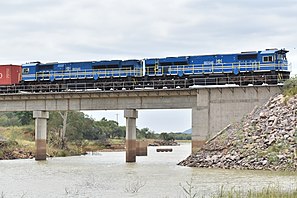Botswana Railways
This article needs additional citations for verification. (December 2024) |
This article's lead section may be too short to adequately summarize the key points. (December 2024) |
| Botswana Railways | |
|---|---|
 | |
| Operation | |
| Major operators | National Rail |
| Part of a series on |
| Rail transport |
|---|
 |
|
|
| Infrastructure |
|
|
| Service and rolling stock |
|
| Urban rail transit |
|
|
| Miscellanea |
|
|
Botswana Railways (BR) is the national railway of Botswana.
History
[edit]Botswana Railways (BR) was established in 1987 when the government of Botswana bought out the Botswana-based sections of the National Railways of Zimbabwe (NRZ).[1] NRZ had been initially operating the rail system after Botswana had gained independence. Management of the BR is supported by RITES Ltd. of India.[citation needed]
The opening of the Beitbridge Bulawayo Railway in Zimbabwe in 1999 resulted in a major drop in the volume of freight transit and income. As a response the BR has been considering the construction of a direct line to Zambia (Zambia Railways), bypassing Zimbabwe, to regain income from transit.[citation needed]
On 27 February 2009, an announcement was made of the termination of all Botswana Railways passenger services.[2] However, passenger trains run by National Railways of Zimbabwe (NRZ) continue to run from Bulawayo to Lobatse via Plumtree, Francistown and Gaborone.[3]
As of October 2010, BR was building a large shopping mall near Gaborone station, and expressed hopes that passenger services might resume, although BR could not give any concrete details.[4]
In December 2014 Botswana Railways announced that they will purchase new passenger cars and locomotives and that passenger services would resume in late 2015.[5] A passenger service between Gaborone and Lobatse, marketed under the name BR Express, eventually began operation in March 2016.[6]
Network
[edit]
The Botswana Railways system consists of 888 kilometres (552 mi) of 1,067 mm (3 ft 6 in) Cape gauge track. The main line runs through the south-eastern region of Botswana from Mahikeng in South Africa through Lobatse, Gaborone, Mahalapye, Palapye and Francistown to Plumtree in Zimbabwe. In addition there are three branch lines: from Palapye to Morupule Colliery, from Serule to Selebi-Phikwe, and from Francistown to Sowa.[citation needed]
- Main Line - 640 km
- Francistown to Sua Pan (branch line) - 174.5 km
- Palapye to Morupule Colliery (branch line) - 16 km
- Private Sidings - 50 km
- Service Sidings - 20 km
- Station Yards - 30 km
- Crossing Loops - 20 km
Fleet
[edit]Locomotives
[edit]As of December 2017[update]
- 8 General Electric UM 22C diesel-electric locomotives, 1982
- 20 General Motors Model GT22LC-2 diesel electric locomotives, 1986
- 10 General Electric U15C diesel electric locomotives, 1990
- 8 General Motors Model (GT42AC) diesel electric, 2017
Purchase of passenger cars and locomotives
[edit]In December 2014 Botswana Railways announced that they would purchase three generator vans, five first class sleepers, 18 economy class coaches, five business class coaches, three buffet cars and a luggage van.[5]
Regional train
[edit]
![BR Express from [[Gaborone]] to [[Francistown]], [[Botswana]]](http://upload.wikimedia.org/wikipedia/commons/thumb/2/20/BR_Express_2.jpg/220px-BR_Express_2.jpg)
Botswana Railways run 2 nightly passenger trains, one from Lobatse to Francistown, and the other from Francistown to Lobatse, with stops in Gaborone, Mahalapye, Palapye, and Serule.[citation needed] The passenger train is termed the "BR Express".[citation needed]
Commuter train
[edit]BR Express operates a commuter train system between Lobatse and Gaborone. The train departs from Lobatse at 05:30 and arrives at Gaborone in 06:49. The train returns to Lobatse in the evening, departing from Gaborone at 18:00 and arriving at Lobatse at 19:34.[citation needed]
The train stops at Otse, Ramotswa and Commerce Park Halt.[citation needed]
Railway links to adjacent countries
[edit]Botswana Railways are connected to Zimbabwe and South African lines, both using the same gauge.[citation needed]
There is no direct connection with Namibia, but one does exist via South Africa, although an electrified railway connecting to Lüderitz in Namibia for coal traffic was scheduled to open in 2006.[citation needed]
In August 2010, Mozambique and Botswana signed a memorandum of understanding to develop an 1100 km railway through Zimbabwe, to carry coal from Serule in Botswana to a deep-water port at Techobanine Point in Mozambique.[7]
A new rail link between Botswana and Zambia, bypassing Zimbabwe, was mooted in 2005 by Botswana Railways (BR) general manager Andrew Lunga. The line was envisaged as running south-westwards from Livingstone, crossing the Zambezi, then continuing to a junction with the existing BR tracks at Mosetse. Lunga's proposal arose following the serious loss of traffic suffered by BR following the opening of the Beitbridge-Bulawayo line, after which annual BR freight tonnage fell from 1.1m per annum to about 150,000. Zimbabwe's economic problems had worsened the situation, prejudicing free traffic flow. The suggested line, Lunga pointed out, would provide important alternative routes linking South Africa, Zambia and the Democratic Republic of Congo.[8]
Gallery of Botswana Rail
[edit]- Botswana Rail in Pictures
-
Botswana railways Train at Francistown station
-
Cargo train at Francistown station
-
Botswana Rail showcasing their work at the World telecommunications and informations society day 2017
See also
[edit]References
[edit]- ^ "BR history" (PDF). Archived from the original (PDF) on 27 September 2007.
- ^ "Tender Process | Botswana Railways". botswanarailways.co.bw. Archived from the original on 25 November 2013. Retrieved 17 August 2017.
- ^ "ZIM-BOTSWANA PASSENGERS DROP". Railways Africa. 20 September 2009. Archived from the original on 9 September 2012. Retrieved 21 September 2009.
- ^ "Give BR a chance". Railways Africa. Retrieved 9 November 2010.
- ^ a b "Passenger train is coming back". Mmegi Online. 14 December 2014. Archived from the original on 26 February 2015. Retrieved 8 October 2015.
- ^ Mouwane, Tumelo. "Mmegi Online :: New, improved passenger train sets off". Mmegi Online. Retrieved 17 August 2017.
- ^ "Railway Gazette: Pointers September 2010". Retrieved 10 September 2010.
- ^ RailwaysAfrica[permanent dead link]





